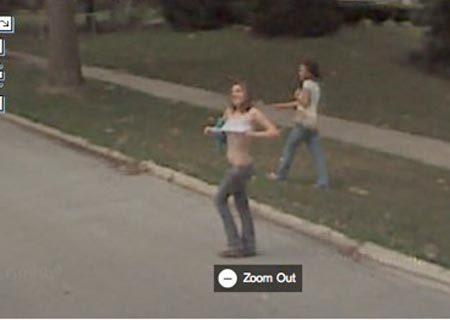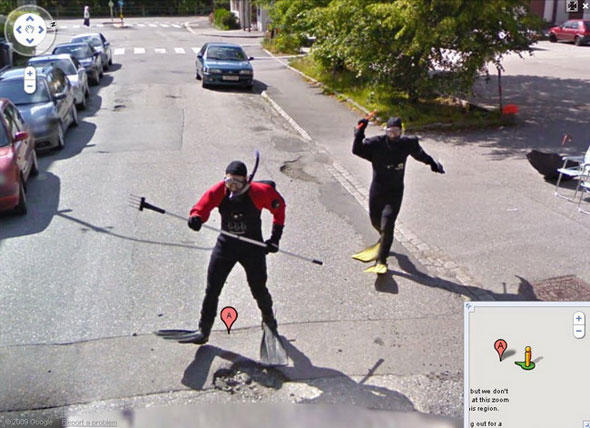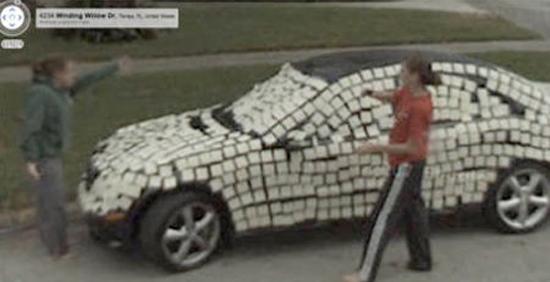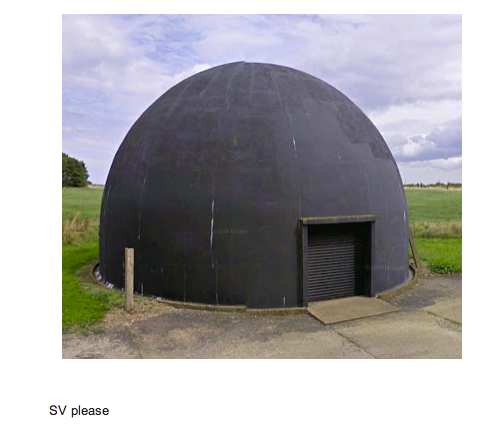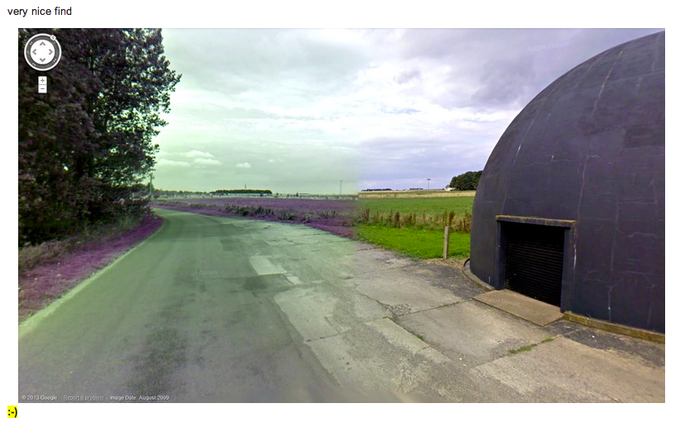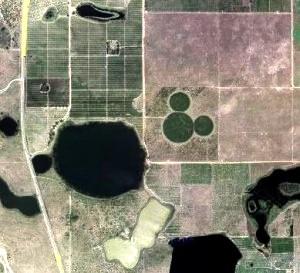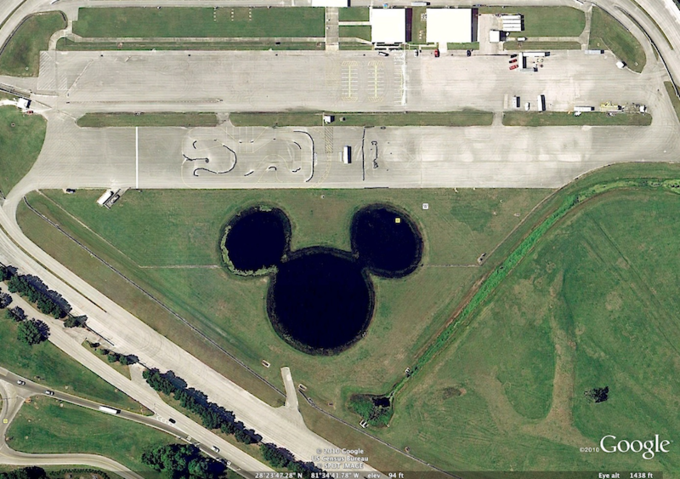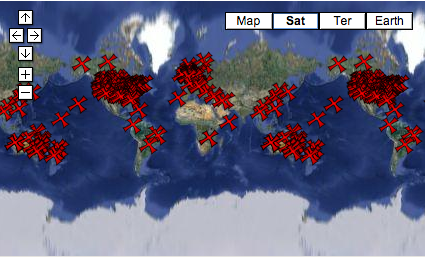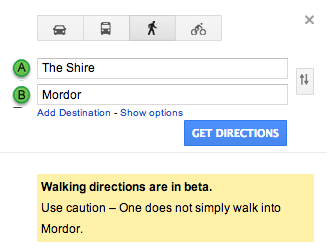About
Google Maps is a mapping website and mobile application created by the American multinational internet and software corporation Google.
History
Google Maps was initially designed as a C++ application by the Australian brothers Lars and Jens Rasmussen and later acquired by Google in October 2004, culminating to its official launch on February 8th, 2005. Google introduced the first mobile application for Google Maps in 2006.
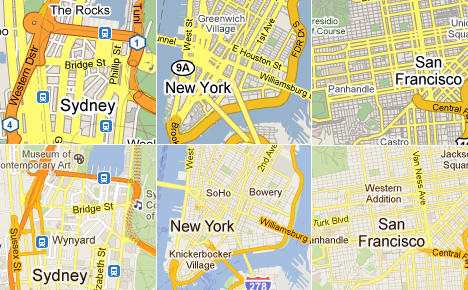
Google Maps’ design evolution between 2009 (top) and 2011 (bottom)
On June 29th, 2007, the first iPhone by Apple was released, which included a mobile Google Maps application. On October 22nd, 2008, the first phone to run Google’s Android operating system was released, which came with a Google Maps application installed.
Features
Satellite View
Google Maps allows the user to view a high-resolution aerial or satellite image over certain areas across the world. Many of the images are taken by aircraft flying at 800-1500 feet from the ground and are approximately one to three years old according to the Google Earth support page.[13]
Google Transit
Google Transit is a public transport route planner integrated into Google Maps, which calculates route, transit time and cost between locations in hundreds of cities worldwide.
Google Places
Google Places is a local business service integrated into Google Maps, which allows business owners to claim a listing to add photos and additional information for their location. The service also allows users to provide reviews for the business, accompanied by a one to five star rating.
On April 30th, 2010, the digital marketing blog Econsultancy[16] published an article describing techniques that could be used to increase a ranking on Google Place’s listings, including using fake addresses, spamming the company name and hiring people to write fake reviews. Following the announcement that Osama bin Laden had been killed on May 1st, 2011, Google Maps users began posting spoof reviews for the bin Laden compound and labelled the site an “amusement park.”[14][15] On March 15th, 2012, the search optimization blog Search Influence[18] published a post about fake Google Places listings, which included a Google Satellite image with a place labelled “Penis Pool” (shown below, right).
Street View
Google Street View is a feature which allows users to zoom in to a 360° panoramic photo taken on the road at a specific location. The photographs are shot by a fleet of Google Street View cars, which include panoramic cameras mounted on the hood (shown below).

From 2009 to 2011, compilations of notable Google Street View photos were published on a variety of Internet humor and tech news blogs, including Holy Taco,[6] The Huffington Post,[7] BuzzFeed,[8] The Next Web,[9] Funny or Die[10] and Mashable.[11]
On January 11th, 2012, Redditor squidesquide submitted a post titled “Click the woman,”[3] which linked to a Google Street View page in Brazil showing a woman fall as the car drove by (shown below). Prior to being archived, the post received over 35,800 up votes and 1,800 comments.
On December 18th, the website Google Street View World[1] was launched, which highlights notable photos taken by Google Street View cars. On January 14th, 2013, Redditor FreddyPenner submitted a link to a Google Street View page in Botswana, Africa,[4] which showed a donkey that appeared to have fallen over after being passed by the Street View car (shown below). Within one month, the post gained more than 3,300 up votes and 400 comments. Two days later, Google Maps group project manager Kei Kawai explained on the official Google Maps blog[5] that the donkey had been lying down and rose when the car approached.
Communities
Several online communities have launched centering around the Google Earth platform. The official one, Google Earth Community[26], allows its users to publish their information to a community layer inside the program. It is broken down into several sub-forums, including boards dedicated to living things, landmarks, weather and sports, among others. Additionally, there is a Fun and Games board[27], where users are encouraged to create riddles and leave hidden messages for each other in the program. Several of these threads often show a location with an instruction on another perspective at which the image should be viewed to see something unique or an error in the data. There is also a separate group called Google Earth for Educators[28], which acts as a hub site for teachers to discuss how they use the program as well as provides resources and tutorials to help teachers incorporate the program in to their curricula.
Highlights
Map Crunch
MapCrunch is a website which allows users to be virtually transported to a randomly selected street view location in Google Maps. The website has inspired a participatory online game in which the player must find their way to the nearest airport from a spawned location. Due to the fact that the initial location is chosen at random, the game has proven to be notoriously frustrating and time consuming. The game saw a rise in popularity from Tumblr in February of 2012, when players began writing about their experiences and uploading pictures from their searches.
Hidden Mickeys
Hidden Mickeys, or subtle three-circle representations of Mickey Mouse that have been placed indiscriminately around the Disney theme parks and other Disney media, have been documented online for years[19], with more than 1000 found to date.[20] Since as early as 2006, Disney enthusiasts have shared coordinates of possible Hidden Mickeys with each other, beginning with a post on the WDWMagic forums[21] in February of that year. Over the years, other fans have shared their Hidden Mickey finds on Talk Disney[22], The Disney Blog[23], WDisneySecrets[24] and DISUnplugged.[25]
Single Topic Blogs
In 2005, a single topic blog called Google Sightseeing[29] launched, highlighting selections in numerous categories including sculptures, landmarks, abandoned sites, crop circles and large crowds. That same year, the blog Google Maps Mania[30] (shown below) was established in effort to track projects utilizing either Google Earth or Google Maps. With contributors from 10 countries, the blog continues to update almost daily as of February 2013.
In 2006, Virtual Globetrotting[31] launched, offering people virtual adventures in a similar vein to Google Sightseeing. In 2013, British window and door company Safe Style UK launched The Secret Door[32], randomly transports users to indoor views found on Google Maps.
Controversies
iOS 6 Maps Controversy
iOS 6 Maps is an application which replaced Google Maps in Apple’s iOS 6 operating system, publicly released on September 19th, 2012. Due to the amount of errors in the app, many iPhone users began posting screenshots of the faulty application and criticizing the way locations were displayed. On December 13th, 2012, a version of Google Maps was made available in the Apple App Store[12] for those who wanted an alternative to iOS 6 Maps.
Privacy Issues
Shortly after its release in 2007, Street View was criticized for violating pedestrian privacy by publishing clear photographs of people out in public. In May of 2008, Google began using facial recognition technology to blur the faces of individuals photographed by Street View cameras. In April of 2010, Google admitted that Street View cars had been collecting data from Wi-Fi networks, including MAC addresses and SSIDs. In March of that year, United Kingdom politician Paul Keetch and anonymous military officers criticized the inclusion of Street View photographs showing the outside of the Special Air Service base in Herefordshire, England.[17]
Internet Meme References
- In September 2011, Google Maps launched an annually updated Pirate Day party locator.
- In December 2011, Google Maps implemented a reminder that one cannot simply walk into Mordor on their walking directions from a Wisconson address masked as the Shire to an address located in Mordor, Illinois.
- In June 2010, Google Maps decorated its street view pegman with the South African stadium horn Vuvuzela.

- In April 2012, Google Maps unveiled a special layer that presented everything in low-resolution 8-bit pixel art.
Search Interest
External References
[1]Official Google Blog – Mapping your way
[2]Google Street View World – Google Street View World
[3]Reddit – click the woman
[4]Reddit – Did Google Street View run over a donkey in the Botswana desert?
[5]Google Lat Long – Never Assume
[6]Holy Taco – 25 Google Street View Prostitutes
[7]The Huffington Post – Google Street Views
[8]BuzzFeed – 93 Awesome Google Street View Photos
[9]The Next Web – The Best Google Street View Fails Wins and WTFs
[10]Funny or Die – 30 Awesome Google Street View Images
[11]Mashable – 10 Must See Google Street View Sightings
[12]iTunes – Google Maps
[13]Google – Blurry or Outdated Imagery
[14]The Huffington Post – Osama Bin Ladens Compound Gets Bad Reviews on Google Maps
[15]The Atlantic – Osama Bin Ladens Compound Already Mapped on Google
[16]Econsultancy – Sneaky Ways to Top Googles Local Listings
[17]The Daily Mail – Fury as Google puts SAS secret base on street view
[18]Search Influence – Fake Google Places
[20]Orlando Attractions Magazine – Author documents 1,000th Hidden Mickey; Fifth edition on sale
[21]WDWMagic – Hidden Mickey on Google Earth
[22]Talk Disney – accidentally found a big hidden Mickey
[23]The Disney Blog – Hidden Mickey on Google Maps
[24]WDisneySecrets – Google Earth Hidden Mickeys
[25]DISUnplugged – A Hidden Mickey Discovery at Disney’s Animal Kingdom
[26]Google Groups – Google Earth Community
[27]Google Groups – GEC: Fun & Games
[28]Google Earth for Educators – Home



